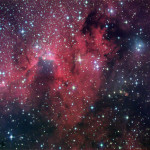 |
Cave Nebula, Dean Salman
Taken with Epsilon 160 F/3.3 astrograph using SBIG ST-10 XME CCD Camera; total exposure of 5 hours 40 minutes using standard red, green, and blue filters. Hydrogen-Alpha filter used to preserve blue reflection nebula; CCD Commander automation imaging to capture image over 3-night period. |
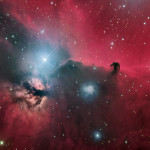 |
Horsehead and Flame, Dean Salman
|
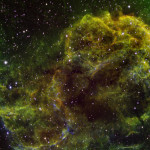 |
Jellyfish Nebula, Dean Salman
Taken with MakNewt 8 inch F/4 astrograph using the SBIG ST-10 XME CCD Camera. I used narrowband filters: Sulfur II for red, Hydrogen-Alpha for green, and Oxygen III for blue to map colors. Total exposure increases with use of narrowband filters; 14 hours over 10 nights; CCD Commander automated imaging. |
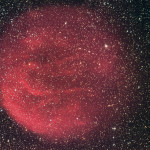 |
Sh2-216, Dean Salman
Second closest planetary to earth taken using Epsilon 160 F/3.3 astrograph using the SBIG STL-6303 XE CCD Camera. I had to use a hydrogen-alpha filter otherwise this kind of detail would not be possible in the 9 hours of exposure time. This image is by far the most published image in a number of books and was one of the four images published in Sky and Telescope’s Beautiful Universe 2008. |
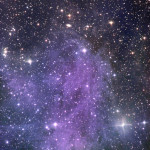 |
Volcano Nebula, Dean Salman
Galactic dust cloud over the Milk Way Galaxy; seen because of the star shine of most red and blue stars giving it color. Taken with Epsilon 160 F/3.3 astrograph using the SBIG STL-6303 XE CCD Camera; 6-hour exposure; taken in the dark skies over New Mexico. (Image published in Astronomy Magazine, September 2007 Issue.) |
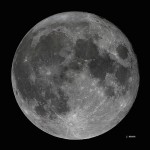 |
Full Moon, J. Militello |
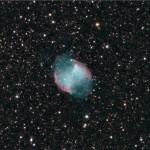 |
M27 Dumbbell Nebula, by Larry Phillips
Dumbbell Nebula in the constellation Vulpecula, NGC 6853 Distance: 1250 light years. Size: N/A Camera: SBIG ST-2000XM Telescope: Astrophysics Starfire 140 EDT F7.5 Mount: Astro-Physics Mach1 GTO with Advanced Telescope Systems portable pier Images: 24 sub images @ 5 minutes each of 6 clear, 6 red, 6 green, and 6 blue for a total exposure time of 2 hours. Date: May 30 & June 1, 2008 Software: Camera, mount, and guider control – CCD Commander & MaximDL, Calibration and stacking – CCDStack, further processing in Photoshop CS2. |
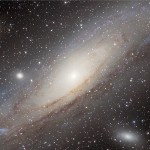 |
(M31) Andromeda Galaxy, Keith Schlottman
This is an LRGB image taken at the Okie-Tex Star Party in October, 2008. Words cannot express the beauty of this galaxy. |
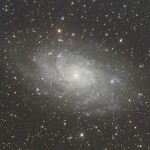 |
M33 the Triangulum Galaxy, Keith Schlottman
This spiral galaxy may be a satellite galaxy to M31. LRGB image taken over several nights between 10/19-10/22/06. M33 is about 3 million light years from us and has many visible star-forming “HII” regions. |
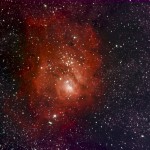 |
Diffuse Nebula M8 – The Lagoon Nebula, Keith Schlottman
Messier Objects are some of the brightest and most beautiful of all deep space objects visible in a telescope. This image of M8 is among images of the Messier Objects taken at Xanadu Observatory or during TAAA star parties. |
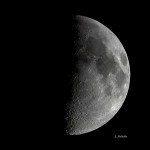 |
Half Moon, J. Militello
It is the 1 webcam image I ever did. The image is a mosaic of 9 images pieced together with Adobe Photoshop. Each image is 100 frames processed and stacked with Registax. I used a StellarVue SV102ED refractor and a Philips SPC900NC webcam. Notice the lunar libration at the north and west limbs. |
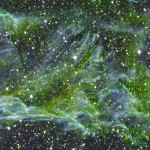 |
NGC 6979, Pickering’s Wedge, Keith Schlottman
This is a narrowband image taken in October, 2008 over several nights, using the Hubble pallet (SII=Red, Ha=Green, OIII=Blue) |
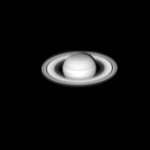 |
Saturn, John Kalas
Saturn is arguably the most fascinating object to observe, certainly it is the best planet. This image was taken in Tucson, AZ on February 14, 2004 when the ring was nearly at its maximum tilt angle (26 degrees vs. 29 degrees maximum). The wide Cassini Division is clearly visible along with the fainter Enke Division further out from the planet. Banding on the planet is also visible. The image was taken through a 130mm f/6 apochromatic refractor telescope using a video webcam. Approximately 600 .AVI frames were processed with Registax to form the image. |
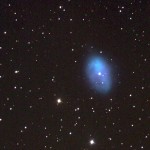 |
Messier 97 & 108, Dean Ketelsen
In this view, planetary nebula Messier 97 (lower left), and galaxy Messier 108 appear close in the sky near the dipper of the Big Dipper asterism, but are actually millions of light years apart – they just happen to line up near each other from our perspective. A close examination of the very faint fuzzy objects close to the limit of exposure are dozens if not hundreds of more distant galaxies. M97 and the multitude of stars visible are part of our galaxy while M108 is about 18 million light years away. This image was taken with a Celestron C-14 telescope + F/1.9 Hyperstar and a Canon 20Da DSLR. |
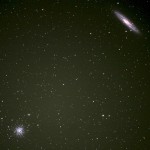 |
NGC 288, NGC253, Dean Ketelsen
Another pair of objects that happen to fall along the same line of sight. NGC 288 is the globular star cluster on the lower left of the image, and NGC 253 is the “nearby” galaxy, both visible in small telescopes in the constellation Sculptor. The cluster and stars visible in the image are part of our Milky Way galaxy while NGC 253 is estimated to be 9 million light years distant. This image was taken with a Meade 80mm F/6 apochromat, .8X field flattener and Canon 20Da DSLR. |
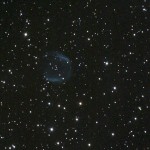 |
Jones1, Dean Ketelsen
Jones1 is a large, faint planetary nebula located in the constellation Pegasus, visible only with a telescope larger than 16″ diameter or so. The normal view of a planetary nebula is usually a full circular ring, while Jones1 is not continuous with only segments of the ring visible. Imaged with an 11.25″ diameter F/4 telescope and a Canon 20Da DLSR. |